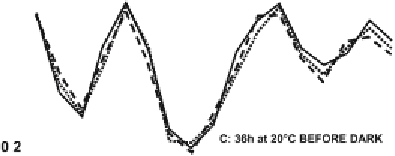Agriculture Reference
In-Depth Information
Fig. 25.10.
Time course of AK activity during darkness. Experimental protocol as for Fig. 25.8
(Frosch and Wagner 1973)
and
C
.
murale
, depends on the photoperiod inductive or non-inductive for
flowering. The statistic evaluation of the propagation direction of the action
potentials could be used as a marker for the induction of flowering in
short- and long-day plants. On the basis of these data, the state of flow-
ering or flower induction of the plant can be determined long before the
first morphological changes at the apical meristem become visible. Our
results furthermore indicate that the action potentials under the influence
of flower-inducing and non-flower-inducing photoperiods are temporar-
ily not uniformly distributed in the dark and light phases of the different
photoperiods, but that they follow a characteristic distribution pattern. To
analyse the correlation between the photoperiodic induction of flowering
as a specific state of the plant material, and the temporal distribution of
action potentials and their direction of propagation, the observed action
potentials had to be classified. Of particular relevance are signals which can



































Search WWH ::

Custom Search